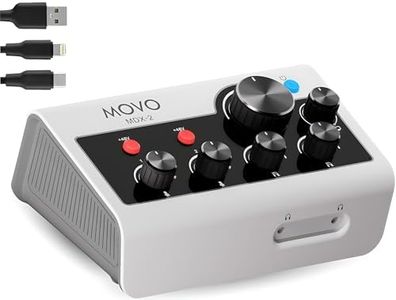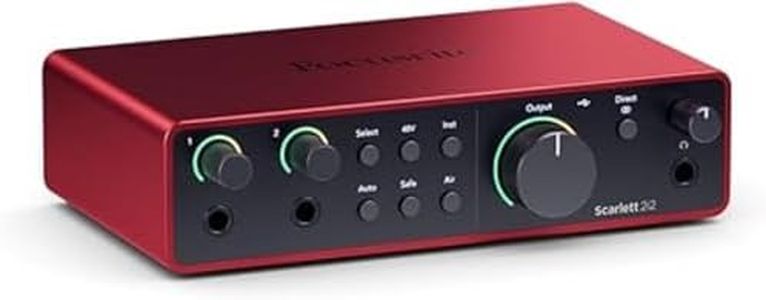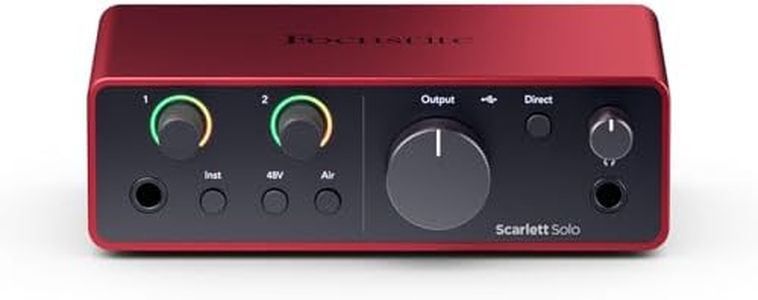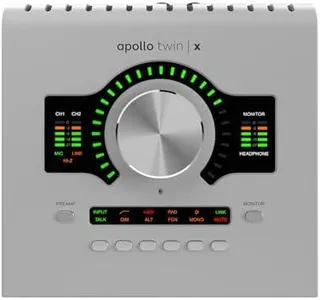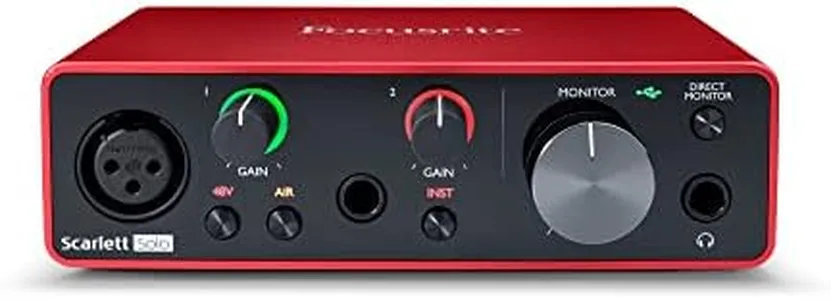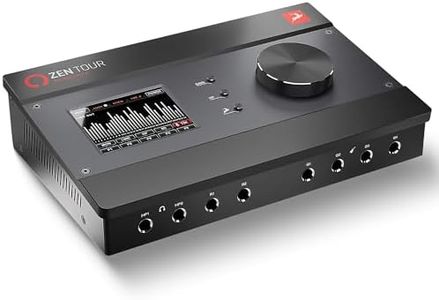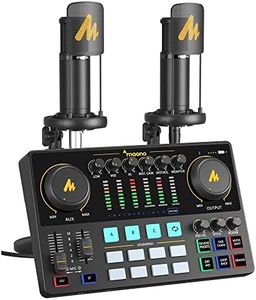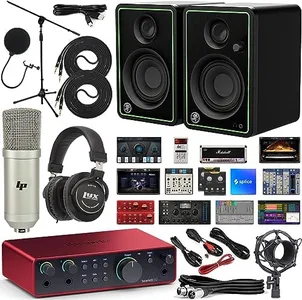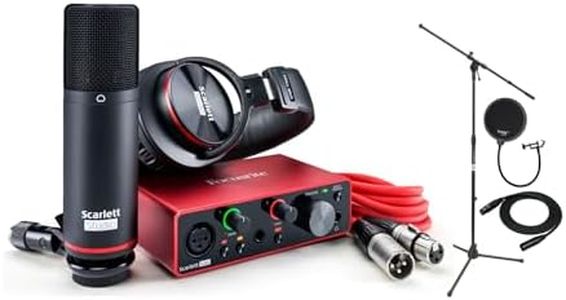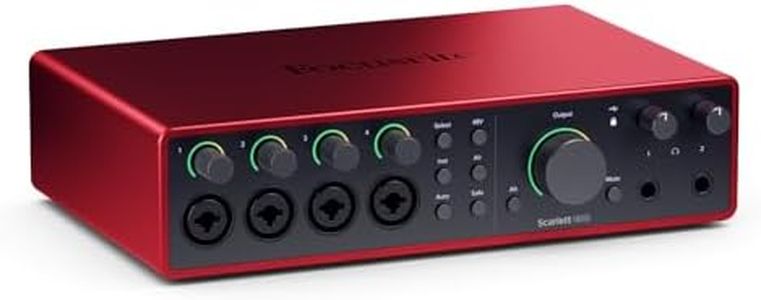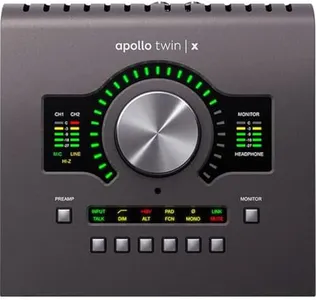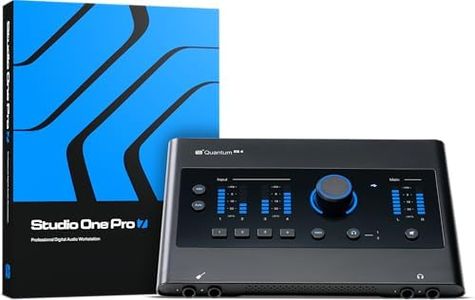10 Best Audio Interfaces 2025 in the United States
Our technology thoroughly searches through the online shopping world, reviewing hundreds of sites. We then process and analyze this information, updating in real-time to bring you the latest top-rated products. This way, you always get the best and most current options available.

Our Top Picks
Winner
Focusrite Scarlett 2i2 4th Gen USB Audio Interface for Recording, Songwriting, Streaming and Podcasting — High-Fidelity, Studio Quality Recording, and All the Software You Need to Record
Most important from
54228 reviews
The Focusrite Scarlett 2i2 4th Gen is a solid choice for anyone looking to record or stream with professional-sounding quality without needing complicated gear. It offers 2 inputs and 2 outputs, which suits solo musicians, podcasters, and small setups. The audio quality is impressive, featuring a 120dB dynamic range and the same converters used in top studio equipment, ensuring clear, detailed sound. Its USB-C connection makes it easy to plug into most computers and even some tablets and smartphones, offering good versatility. It provides phantom power for condenser microphones, which is essential for many vocal and instrument mics.
The built-in preamps are highly regarded, delivering clean and transparent sound with an added “Air” mode that brightens vocals and guitars for a more polished result. Latency is kept low, so you won’t notice delays while recording or performing live. The unit’s aluminum body is compact and sturdy, making it portable and durable for home or on-the-go use. One big plus is the included software bundle, which gives you popular recording programs and plugins to get started right away without extra purchases.
On the downside, with only 2 inputs, it’s less suitable if you plan to record multiple sources simultaneously or larger bands. Also, while the USB 2.0 interface is reliable, it’s not the fastest standard available, though this rarely impacts typical home recording. The Scarlett 2i2 4th Gen delivers excellent sound quality, user-friendly features, and decent portability, making it among the best options for beginner to intermediate audio interfaces aimed at recording, streaming, and songwriting.
Most important from
54228 reviews
Focusrite Scarlett Solo 4th Gen USB Audio Interface, for the Guitarist, Vocalist, or Producer — High-Fidelity, Studio Quality Recording, and All the Software You Need to Record
Most important from
54228 reviews
The Focusrite Scarlett Solo 4th Gen is a compact and user-friendly USB audio interface designed mainly for solo musicians like guitarists, vocalists, and producers who want high-quality recordings without complicated setups. It offers two inputs—one for a microphone (with phantom power for condenser mics) and one for instruments like guitars—making it ideal for recording vocals and guitar simultaneously. The audio quality is excellent for its category, featuring a wide 120dB dynamic range and the same converters used in Focusrite’s professional studio gear, ensuring clear and detailed sound. The new Air mode enhances vocals and guitars by adding brightness and presence, which can help your recordings sound more polished right away.
Connectivity is straightforward via USB-C, compatible with Mac, Windows, iOS, and even ChromeOS devices, making it versatile and easy to set up. Latency (the delay between playing and hearing sound) is well-managed, so you won’t experience annoying lag while recording. The built-in preamps are clean and provide good gain, so your recordings maintain clarity without unwanted noise. The device is compact and lightweight, perfect for musicians on the go or with limited space.
Included software is a strong point: you get popular tools like Pro Tools Intro, Ableton Live Lite, and a generous trial of FL Studio Producer Edition, plus useful plugins to help with mixing and mastering without additional purchases. This makes it a great start for beginners or those who want an all-in-one recording solution. However, with only two inputs and outputs, it’s not suited for users who need to record full bands or multiple instruments simultaneously. If you plan to expand your setup or need more flexible routing, you might find it limiting. Also, while the build is sturdy enough for home and small studio use, it’s not heavily ruggedized for rough transport. The Scarlett Solo 4th Gen is a highly suitable choice for solo artists and producers focusing on vocals and guitar, offering professional-level sound, hassle-free connectivity, and plenty of useful software to jumpstart your music creation journey.
Most important from
54228 reviews
Focusrite Scarlett 18i20 4th Gen USB Audio Interface, for Multitrack Recording, Music Production and Podcasting — High-Fidelity, Studio Quality Recording, and All the Software You Need to Record
Most important from
2954 reviews
The Focusrite Scarlett 18i20 4th Gen USB Audio Interface is a robust choice for anyone involved in multitrack recording, music production, or podcasting. It offers an impressive 18 inputs and 20 outputs, which is excellent for complex audio setups. The inclusion of eight high-quality mic preamps, versatile connectivity options like Hi-Z, line inputs, ADAT, S/PDIF, MIDI I/O, and Word Clock, makes it highly adaptable for various recording scenarios.
The audio quality is top-notch with 24-bit, 192kHz converters and a 122dB dynamic range, ensuring detailed and high-fidelity recordings. The Air mode feature is a significant plus, adding classic studio console character to vocals and instruments, elevating the sound quality. Additionally, the Auto Gain and Clip Safe features are incredibly useful for maintaining optimal recording levels and preventing audio clipping, enhancing the recording workflow. The interface is compatible with all major audio recording software and comes with a comprehensive software bundle, including Pro Tools Intro+, Ableton Live Lite, and FL Studio Producer Edition, adding significant value.
The build quality is solid with an aluminum body, and while it's not the lightest interface at 8.04 pounds, it is durable and built to last. The USB-C connectivity ensures fast data transfer, though some users may need to ensure they have the necessary ports on their devices. One potential drawback could be its size, which might be cumbersome for those with limited space or who need a highly portable setup. Despite this, the Scarlett 18i20's blend of high-quality audio, versatile connectivity, and professional-grade features makes it an excellent choice for both home studios and professional environments.
